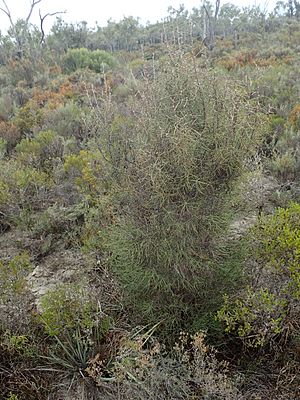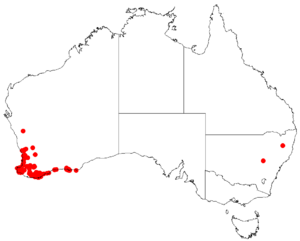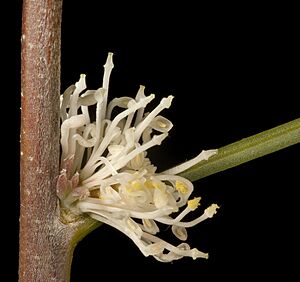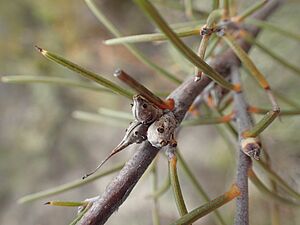Furrowed hakea facts for kids
Quick facts for kids Furrowed hakea |
|
|---|---|
 |
|
| Hakea sulcata in the Lake Wannamal Nature Reserve | |
| Scientific classification | |
| Genus: |
Hakea
|
| Species: |
sulcata
|
 |
|
| Occurrence data from Australasian Virtual Herbarium | |
Meet the Hakea sulcata, also known as the furrowed hakea. This unique plant belongs to the Proteaceae family. It grows only in Western Australia, making it an endemic species. It's a prickly shrub with cool, grooved leaves. When it blooms, it has sweet-smelling flowers and small fruits.
Contents
What Does Furrowed Hakea Look Like?
The furrowed hakea is a small shrub. It can grow from about 0.4 to 2 meters (1 to 6.5 feet) tall. It spreads out or grows straight up. Unlike some plants, it does not have a special woody swelling at its base called a lignotuber.
Its branches can be covered with soft, silky hairs. These hairs can be thick or thin, especially when the plant is flowering.
Leaves of the Furrowed Hakea
The leaves of this plant are like needles. They are thick and have five sides if you cut across them. They are usually between 2 and 12.5 centimeters (0.8 to 4.9 inches) long. Each leaf is about 1 to 2 millimeters (0.04 to 0.08 inches) wide. They grow one after another along the branches.
A cool thing about these leaves is that they have 6 or 7 shallow grooves running along them. This is why it's called "furrowed" hakea! Each leaf also ends in a sharp point. Sometimes, the leaves can look a bit different. They might be flat, curved, or shaped like a narrow egg.
Flowers and Fruit
The furrowed hakea has groups of 8 to 14 white flowers. These flowers smell sweet! They grow in clusters where the leaves meet the stem, or on older parts of the wood.
Each flower has a smooth, cream-white stalk. The main part of the flower is also cream-white. The female part of the flower, called the pistil, is about 5 to 9.5 millimeters long.
The fruits of the furrowed hakea are the smallest in its plant group. They are shaped like an egg. They are less than 0.6 to 0.8 centimeters (0.24 to 0.31 inches) long. They are also about 0.3 to 0.35 centimeters (0.12 to 0.14 inches) wide. The fruit surface is usually smooth or a little bumpy. It becomes rougher as it gets older and ends in a point.
How Was Furrowed Hakea Named?
The Hakea sulcata was first officially described in 1810. A botanist named Robert Brown wrote about it. He published his description in a scientific paper called Transactions of the Linnean Society.
The name sulcata comes from a Latin word, sulcatus. This word means "grooved." It refers to the special grooves found on the plant's leaves.
Where Does Furrowed Hakea Grow?
The furrowed hakea grows only in Western Australia. You can find it in several regions there. These include the South West, Great Southern, and Goldfields-Esperance areas.
Its range stretches from Gingin in the north to Albany in the south. It also grows from Augusta in the west to Esperance in the east. This plant prefers to grow in sandy or clay soils. It often grows over or near areas with laterite, which is a type of reddish soil.
Is Furrowed Hakea Endangered?
The good news is that Hakea sulcata is not considered threatened. The Western Australian Government's Department of Parks and Wildlife has classified it as "not threatened." This means it is doing well in its natural habitat.



